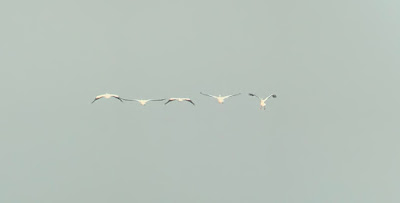10. Harlequin Duck--rare in Pennsylvania, a very enjoyable sighting of a continuing female bird up in north central Pennsylvania when I had to drive up to give a talk in Williamsport in November.
9. Black Scoter--rare for the county, was able to find a beautiful pair on the river behind the Philadelphia airport during spring migration.
8. Least Bittern--pretty easy to find at the John Heinz NWR within a hundred yards of Delaware County, was glad to finally get one on the Delaware County side.
7. Red-headed Woodpecker--not seen in the county every year, I was happy to find a nice adult bird at Heinz NWR in early May.
 |
| Worst shot ever of Red-headed Woodpecker, John Heinz NWR |
6. Yellow-throated Warbler--at the top of my wish list for the year for Delaware County, after missing a few in 2018. A singing bird was found at Ridley Creek State Park in the spring and I was able to relocate it and enjoy it singing one Saturday afternoon in May.
5. Ross's Goose--rare but regular in the region, managed to get one for my yard list by scanning huge flocks of migrating Snow Goose that I was able to see one day after hearing that birds were moving through the area.
4. Blue Grosbeak--after missing this new bird for me for the county a mile from my home while sick this spring, I managed to find a nice male myself behind the Philadelphia airport later in the summer.
 |
| Not easy to shoot a Blue Grosbeak against a blue sky! PHL airport, Delaware County, PA |
3. American White Pelican--another first for me for Delaware County, seen the evening before flying south over the county, hoped they might have put down on the river for the night and was fortunate to find them down there the next morning.
 |
| More bad shots of good birds, American White Pelicans on the Delaware River |
2. Brown Booby--probably my best solo find of the year, a review species for the state, a bird flying up the Delaware River behind the Philadelphia airport back in the spring.
1. Laysan Albatross--a bird I've wanted to see since I was a kid in Oregon. Finally got several from land on the north shore of Oahu in March.
I managed to squeak out 201 birds for Delaware County this year, passing 200 for the second year in a row. But after hitting 200 in September I just saw one more for the year. Too much attention to other things in my life, not enough birding.
As far as life birds, I only got four new birds for the year, thanks to a quick conference trip to Oahu in March--Laysan Albatross, Sooty Tern, Japanese Bush-Warbler, and Yellow-fronted Canary.
Looking back on the decade, some modest but good birding across the country and around the world, with trips to the Netherlands, Spain (long layover), Germany (airport birding on a layover), the United Arab Emirates (so great), Mexico (several research trips), Canada, and New Zealand (gotta get back!). I only got 160 new birds this decade. I would like to be getting at least that many, if not ten times as many, each year!
So for the coming decade, I would like to do much more overseas birding, and see most of the scattered regularly occurring birds I haven't seen yet in North America. I've been to almost 40% of U.S. counties, and would like to boost that up to over 60% as well (maybe more). And I'd like to hit all the Canadian provinces and territories--especially Nunavut. If we stay in Delaware County, it would be nice to get over 275 on my county list, I doubt we will live here for me to get to 300 (Al Guarente is the only person with that total for the county in eBird, achieved this year after a lifetime of birding hear--congratulations Al!).
Best birding wishes to all for 2020 and for the 2020s!

















